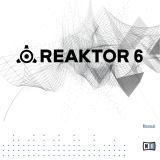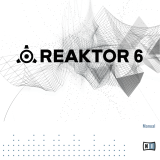Page is loading ...

E350 Morphing Terrarium
www.synthtech.com/euro/e350
What is the E350?
The Synthesis Technology E350 is a 2-output wavetable VCO. There are 3 banks of 64 wavetables.
Each bank is arranged like a chessboard: there are 8 rows (the ‘X’ direction) and 8 columns (the ‘Y’
direction). Waves in a row tend to be alike, or will progress from ‘dark’ to ‘bright’ in timbre. The E350
has independent controls to index/select where in this array the DSP ‘scans’ the data to generate these
2 outputs. The DSP has sophisticated algorithms that smooth the 2 outputs into over 24,000 unique
waves.
Connecting to the power supply
The E350 can use either a MOTM 4-pin, MTA-156 style connector (+-15V) or a 16-pin Euro style (+-
12V) connector. See the photos below. The Euro ribbon cable has a red stripe to indicate
-12V. The supplied Euro power cable is keyed so that when inserted in the E350, the red stripe is
‘down’ (towards the jacks) and by the white lettering on the pc board.

Controls and Jacks
1 - COARSE frequency control covers ~ 8 octaves
2 – FINE frequency control covers ~ 0.5 octaves
3 – FM amount. This is an attenuator for whatever is plugged into the FM jack (#10). The response is
exponential.
4 – MORPH X. This control sets the initial starting point for the wavetable XY OUT, as indexed in the
current ‘row’.
5 – MORPH Y. This control sets the initial starting point for the wavetable XY OUT, as indexed in the
current ‘column’.
6 – MORPH Z. This control sets the initial starting point for the wavetable Z OUT. It scans through all
64 waves in the selected bank. This is useful to ‘audition’ all of the waves in the selected bank.
7 – RANGE switch. Selects 3 different frequency ranges for the E350. The total range is 1 cycle in 13
minutes to 10KHz.
8 – BANK switch. Selects 3 different sets of 64 waves. Bank A has mostly sine waves in different
harmonic series and includes a few Hammond drawbars sets. Bank B is a wide assortment and includes
male/female vocal formants. Bank C is specifically designed for LFO/modulation waveforms, but can
also be used in the audio range. For a complete description, see the User Manual.
9 – 1V/OCT input. This sets the pitch tracking of the E350. There is factory trimmer for this setting
located beside the FINE pot on the first pc board.
10 – FM input. Can be DC to 8KHz, and is attenuated by the FM panel control.
11 – SYNC. A positive voltage exceeding 0.25V will place the E350 into hard sync (both outputs reset to
-5). In normal operation, another VCO is used to ‘drive’ sync.
12 – MORPH X. This voltage is added to the panel control to index the XY OUT wave along a ‘row’.
13 – MORPH Y. This voltage is added to the panel control to index the XY OUT wave up/down a
‘column’.
14 – MORPH Z. This voltage is added to the panel control to index the Z OUT wave for all 64
wavetables in the selected bank. It starts at Row 1, Column 1 (wavetable 1) and goes to Row 8 Column
8 (wavetable 64).
15 – XY OUT. This output (10V pk-pk) is a DC-coupled wave that is the result of all the MORPH X and
MORPH Y settings.
16 – Z OUT. This output (10V pk-pk) is a DC-coupled wave that is the result of the MORPH Z settings.
General Info
Inputs: -5V to +5V, DC to 8KHz.
Outputs: -5V to +5V, DC to 10KHz
Power: +12V@55ma, -12V @25ma. For MOTM use: +15V @45ma, -15V@ 15ma.
Jumper options: JP7 – Morphing Wavetables operation (OFF) Phase Shift Mode (ON)
JP8 - Interpolation Enabled (OFF) Interpolation Disabled (ON)

!"#$%&'()*+%,+-.%/0-12*+%3-456
,')5
789-:;
<-*1=5
!>?-
@AB 0<C
D
D
,3
7E
F);51?-+*;5
G*H5%@AB
DI%CJ;
K%CJ;
I
I
L
L
L
K
K
L
&M):
@5(5)4
N)-O
P*:Q
RE< R)*+-(%9%E'(';*+
<-)H51;51
ER< E'(';*+%9%R)*+-(
<-)H51;51
@S, @-.%S*==%,'+;51
@AB @--Q%A?%B*O+5
0<C 0J251':*++M
<-);1-++54
C=:'++*;-1
RE<
RE<
RE<
RE<
ER<
ER<
"14T-1451
U5==5+
@S,
"14T-1451
U5==5+
@S,
V*)(5%&.';:W
X
3
@
YE
F);51?-+*;5
G*H5%@AB
U*)Q%&.';:W
R
U
<
7TZ
7TZ
7T[\

!"#$%&'()*+%,+-.%/01*23%4-536
,')3
789-:;
<-*=23
!>?-
@AB C<D
E
E
,4
7F
G);3=?-+*;3
H*I3%@AB
EJ%DK;
L%DK;
J
J
M
M
M
L
L
M
&N):
@3(3)5
O)-P
Q*:R
SF< S)*+-(%9%F'(';*+
<-)I3=;3=
FS< F'(';*+%9%S)*+-(
<-)I3=;3=
@0, @-.%0*22%,'+;3=
@AB @--R%A?%B*P+3
C<D CKT3=':*++N
<-);=-++35
D2:'++*;-=
SF<
SF<
SF<
SF<
FS<
FS<
"=5U-=53=
V3223+
@0,
"=5U-=53=
V3223+
@0,
W*)(3%&.';:1
X
4
@
7F
G);3=?-+*;3
H*I3%@AB
V*)R%&.';:1
S
V
<
$U"Y$
U7%;-%M7
7UYZ
M



/





